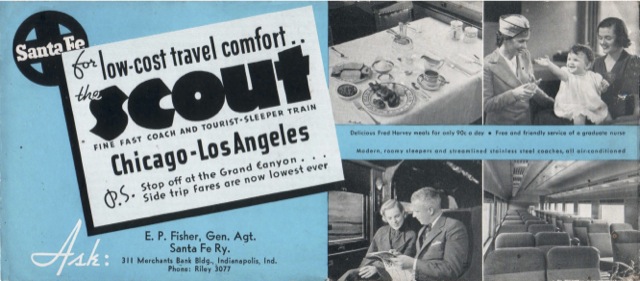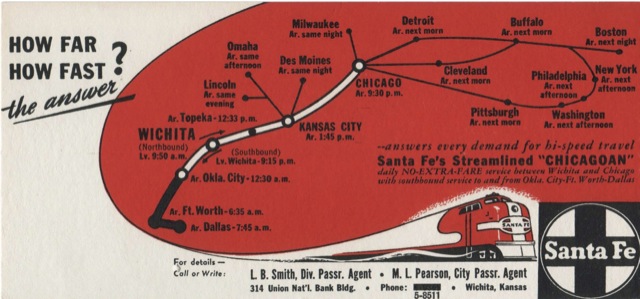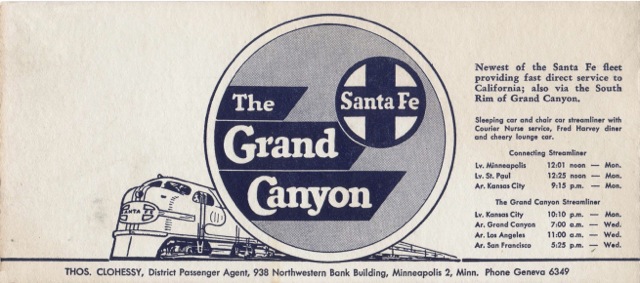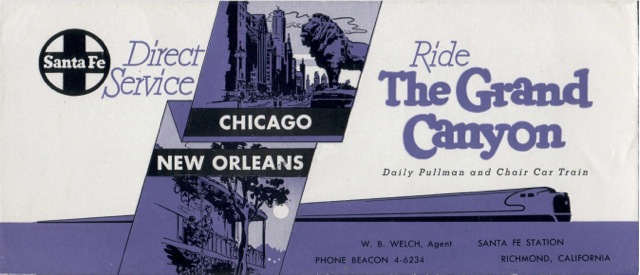Today’s blotters, all of which are from the Dale Hastin collection, advertise some of Santa Fe’s less-important trains, starting with the Scout, Santa Fe’s answer to Union Pacific’s Challenger. Inaugurated in 1916, the train died in the early years of the Depression and then was revived in 1936 (the year after the Challenger) and was given train numbers 1 and 2. However, the train was terminated in 1948, effectively being replaced by the El Capitan the year that train became a daily.

Click images to download PDFs of the blotters, which are 0.3 to 0.6 MB in size.
The blotter also advertises Santa Fe’s office in Indianapolis, which was located in the Merchants Bank Building, now known as the Barnes and Thornburg Building. This building was designed by the prestigious architectural firm of Daniel Burnham. Though Burnham is often associated with the “Chicago school” of architecture, he actually predates that school and his buildings are more of a classical style.
The second blotter advertises the Chicagoan, which offered a daytime streamliner between Kansas and Chicago to complement the overnight Super Chief and El Capitan. The blotter also advertises Santa Fe’s office in Wichita’s Union National Bank Building. This building became famous when a soda fountain on its first floor was the site of a 1958 civil rights sit-in. More recently, the building has been turned into an expensive boutique hotel.
The third blotter advertises the Grand Canyon. The picture implies that the train was pulled by Santa Fe E1 locomotives, which is doubtful but probably dates the blotter to the late 1940s. The blotter lists the Santa Fe office in the Northwestern National Bank Building in Minneapolis. Built in 1930, this 16-story building was devastated by a 1982 Thanksgiving Day fire, leading the owners to implode the surviving shell in 1984.
The final blotter is also for the Grand Canyon but has a more modern appearance. For some reason, it implies that the train is a “direct route” either from both Chicago and New Orleans to the Grand Canyon or from Richmond, California to Chicago and New Orleans. In fact, Santa Fe didn’t even reach New Orleans. The 1953 timetable shows New Orleans tourists destined for the Grand Canyon would take Missouri Pacific train 3 to Houston, then Santa Fe train 66 to Temple, train 75 to Texico, train 97 to Clovis, train 23, the Grand Canyon, to Williams, and from there another train or bus to the Grand Canyon. In 1953, there was a through car from Houston to Oakland (meaning also Richmond), but not all the way from New Orleans, though there may have been one in some other year.
The blotter also advertises Santa Fe’s ticket office in its Richmond, California train station. Santa Fe’s right-of-way in the area has since been taken over by BART; some BART overpasses still bear a Santa Fe logo. The wooden structure that served as Santa Fe’s train station was demolished in the 1990s.




There was a through sleeper New Orleans to Houston (via M.P.) and thence from Houston to Oakland via Sweetwater and Clovis for a brief time after the new San Francisco Chief was inaugurated in 1954, but it was gone by 1957. Houston to Oakland (later terminated in Richmond) through service, however, continued all the way until Santa Fe determined to terminate the California Special in late 1967.